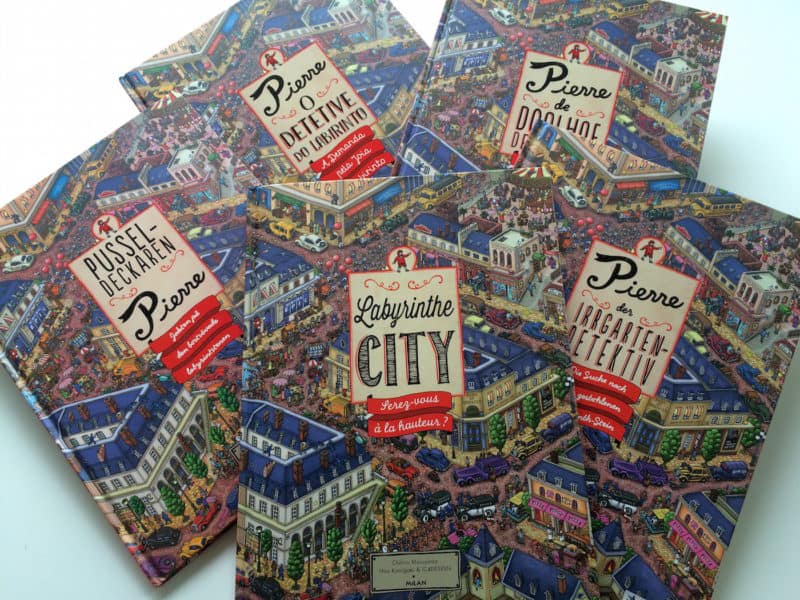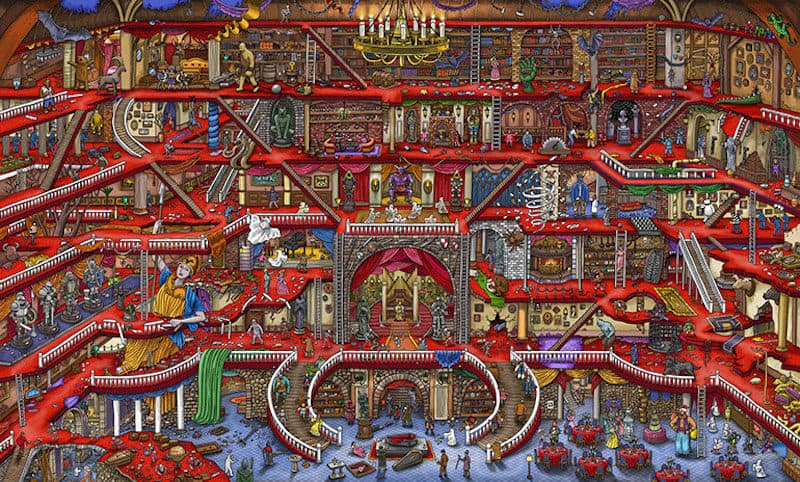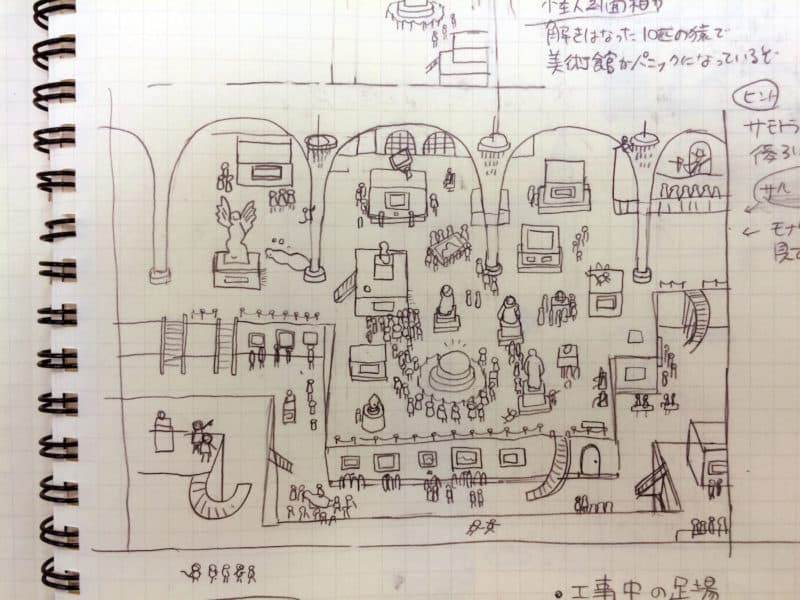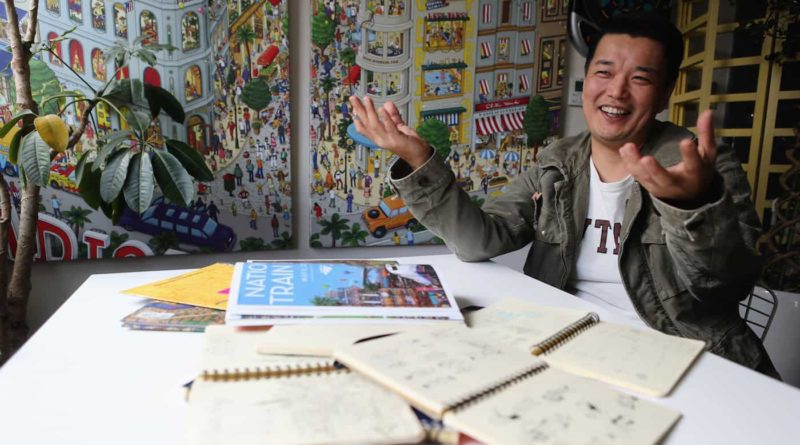The Wonderful World of Detail-Crazed Maniac Hiro Kamigaki
The name may not be familiar, but there is a good chance that you have come across the intricately detailed, playful artwork of Hiro Kamigaki and his ICA design team. International travelers at Hiroshima Airport are greeted by a colorful, IC4-penned overview of the region spread across the terminal doors. In souvenir shops, their package design for Mitchan, one of the original purveyors of Hiroshima okonomiyaki, evokes the nostalgia of the city’s post war reconstruction era. You’ll find their work on shopfronts, walls, PR materials and in stationery stores all around the city. Their work has found favor overseas too. An IC4 cover led the launch of a redesigned New York Times Magazine in 2009. Described admiringly by Design Director, Arem Duplessis, as “incredibly detail-crazed maniacs”, IC4 provided a mind-bogglingly intricate fine line drawing that was perfect for the issue’s infrastructure theme.

A year later, they provided the look of Amtrak’s nationwide National Railway Day and more overseas print commissions followed. On the web, the emoticons in Google Hangouts are IC4 designed. You can even pick up an IC4 Burton snowboard for your kids.

I am visiting IC4 headquarters just south of Hiroshima’s Peace Boulevard, to talk about their most ambitious project so far, a gorgeous picture book, Pierre The Maze Detective, conjured up from the mind of Hiro Kamigaki. Published in Japan in 2014, the book has been translated into 17 languages and made its international debut in September 2015. Described by one parent in The Guardian as “Where’s Wally’s posh cousin”, Pierre is now finding his way onto bookshelves and into the hearts of children (and adults) around the world. 6 weeks after its overseas publication it had already sold 75,000 copies, with the lucrative Christmas gift-buying season still ahead.

For those who haven’t kept up with the news from Opera City, criminal mastermind Mr X has stolen the Maze Stone which has the power to turn the whole city into a maze. Pierre the Maze Detective, a kind of young, gallic Sherlock Holmes, aided by his friend Carmen, pursues Mr X across 15 beautifully drawn double page cityscapes. Readers make their way through the mazes, picking up clues and completing challenges along the way. Children love it, but it is a book that appeals to the whole family, in much the same way as a board game might. Enjoying the book with my own kids, I found it quite addictive and, at times, challenging. 
I am immediately struck by the size of the English version, much larger than my Japanese copy. Kamigaki tells me that he originally envisioned an even larger book. The sizes, it turns out, are limited by the standard size of bookstore shelves. Exceed these dimensions, and getting stores to carry your book is very tough. There are other differences too. While the Japanese book is glossy, the English version has a matt finish which gives it a retro look that more closely matches the feel of Opera City which is evocative of the interwar years. The quality of the Japanese print, however, isn’t quite matched by that of the international versions printed in China, Kamigaki says. Subtle changes have also been made to the illustrations to avoid possible problems in overseas markets.
Notable amongst these are references to alcohol. Kamigaki says seeing guys crashed out in Peace Memorial Park was just part of growing up in Hiroshima. He didn’t think twice about drawing a cafe table covered with glasses of wine or guys passed out in a town square surrounded by empty bottles. In the English version, the wine is replaced by milk, the bottles by crumb-covered plates and half-eaten cakes. One character downing a bottle of beer now inhales a hot dog.
Hiro Kamigaki is an incredibly affable chap and the IC4 office is relaxed and feels like a fun place to come and work. Though undoubtedly driven, it seems that this easygoing nature has attracted a good deal of karmic good fortune which has helped bring Pierre to the world. A picture book was something that had been on Kamigaki’s mind for many years. He agreed, after some initial hesitation, to a request from a Japanese publisher to create a maze book, on condition that he would have complete artistic freedom. During the two years it took to complete Pierre, maze books underwent something of a boom and inquiries from other publishers started to come in.
One was from UK creative arts publisher Laurence King. The Japanese publisher had made it clear that they planned to focus solely on the domestic market, but selling the idea of a picture book to overseas publishers was something Kamigaki definitely had his sights set on. A new book would have taken another 2 years to create, but Laurence King loved Pierre and they were keen to take it on. In a stroke of good fortune, the Japanese publisher was happy to let Kamigaki sell the international rights. Everything seemed to be going well. Then the draft contracts arrived. “Pages and pages of legalese in the Queen’s English. “We had no clue!” Kamigaki laughs. Once again serendipity struck. American illustrator, Naomi Leeman, happened to be working at the IC4 office. She offered to help with the contract negotiations and, after much to-ing and fro-ing, a deal was struck. Laurence King’s passion for creative work and an appreciation of the importance of marketing and PR, combined with a strong commitment to take Pierre around the world made it the perfect partner.
When asked about his path to Pierre, Kamigaki sheepishly admits that he wasn’t particularly interested in maze books as a kid. After giving props to ukiyo-e woodblock print masters, Kazuhisa Hokusai in particular, he points to two chance encounters that had a big influence on him. The first was his mother taking him to see an exhibition of work by Shusei Nagaoka (known for his record cover designs for Earth, Wind and Fire) at a department store when he was 13 or 14. He was deeply impressed by Nagaoka’s futuristic cityscapes. Then came his discovery of the Franco-Belgium Bande dessinée when he happened to pick up a copy of a Moebius comic off the floor in a friend’s bedroom. The meticulous detail blew him away, he says. Flicking through some pages he comments on how many of the drawings he likes are mostly devoid of people. Although much of his work is now packed with hundreds of tiny people, it’s actually the cityscapes that Kamigaki enjoys working on most. He recalls seeing a Where’s Wally? window display on returning from college in Fukuoka. It was clear to him that readers were really responding to these scenes packed with people. He shrugs and says, that was when I realized that I needed to start populating my drawings. Opera City, the setting for Pierre, was thought up Chihiro Maruyama who supplied the text for the book. Loosely based on his idea of Paris, it is really an amalgam of his image of European and American cities of the interwar years. This was partly practical. Flat rooftops don’t make for a fun maze, so European roofs, with their peaks and interesting design features made sense. Pierre actually started out as Peter or Pete. From there came the idea that his friend should be Spanish, and so Carmen was born. Mr X was inspired by a villain in a Scotland Yard board game he used to play as a kid. “I’ve always been a fan of the design of the 1920s and 1930s and I have this idea that it was a time when people lived life full of passion and vitality.” Kamigaki says that his time working for a video game company, similar to the ones on 비트코인 카지노, also influenced the way the book turned out, something you can definitely feel when you read it. He smiles, and says, a little embarrassed, “I also absolutely love Disneyland.” Kamigaki estimates that each of the 15 spreads spreads took around a month of work to complete.


Having to pay the bills with their commercial work, much of the work on Pierre would be done working late after hours and on holidays. He gets most of the spreads about 50% done, returns to build them all up to 80-90% complete, then he adds the final finishing touches. The many sub-plots that run through the book featuring recurring characters such as a refined polar bear, a samurai and, of course, a ninja, were all added right at the end when the book was about 99% complete. He shares a seemingly obvious, but genius tip. Over a two year project, it is inevitable that you improve as you go along. So, he makes a point of working on the first page last, to make sure the book starts with a bang. As our conversation draws to a close, Kamigaki shares a story. When he was a kid, a local school had one of the strongest baseball clubs around. Competition to make the team was fierce. One guy who despite not being particularly gifted was consistently picked for the team. His secret? He did whatever he could to make sure that he stood out. He knew he’d only get picked if the coaches remembered who he was, so he did whatever he could to make it impossible for them not to. Kamigaki says that this has always been his tactic as an illustrator. It is, of course, important to be skilled, but your work has to grab the attention of the viewer, whether that be a potential commercial client or a customer in a bookstore. He has always looked to set himself apart, to create a first impression strong enough to stop someone in their tracks and compel them to take a closer look. “In the bookstore, it doesn’t matter how good your book might be if no one stops to pick it up. You live and die by the first impression, you have to stand out from the crowd.” Pierre The Maze Detective is now available worldwide in many different languages and we eagerly await what will next to emerge from the mind of Hiro Kamigaki.
IC4 Design
URL: http://www.ic4design.com/
Twitter https://twitter.com/ic4design_dsk





